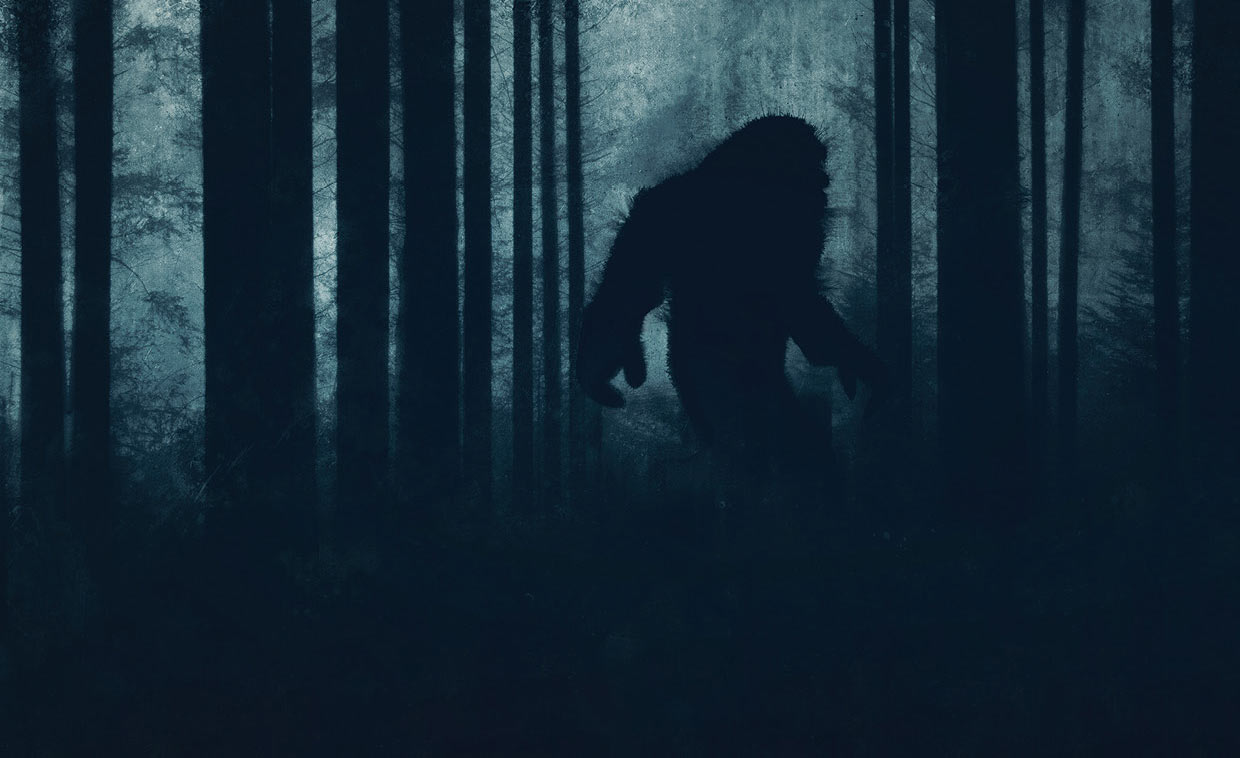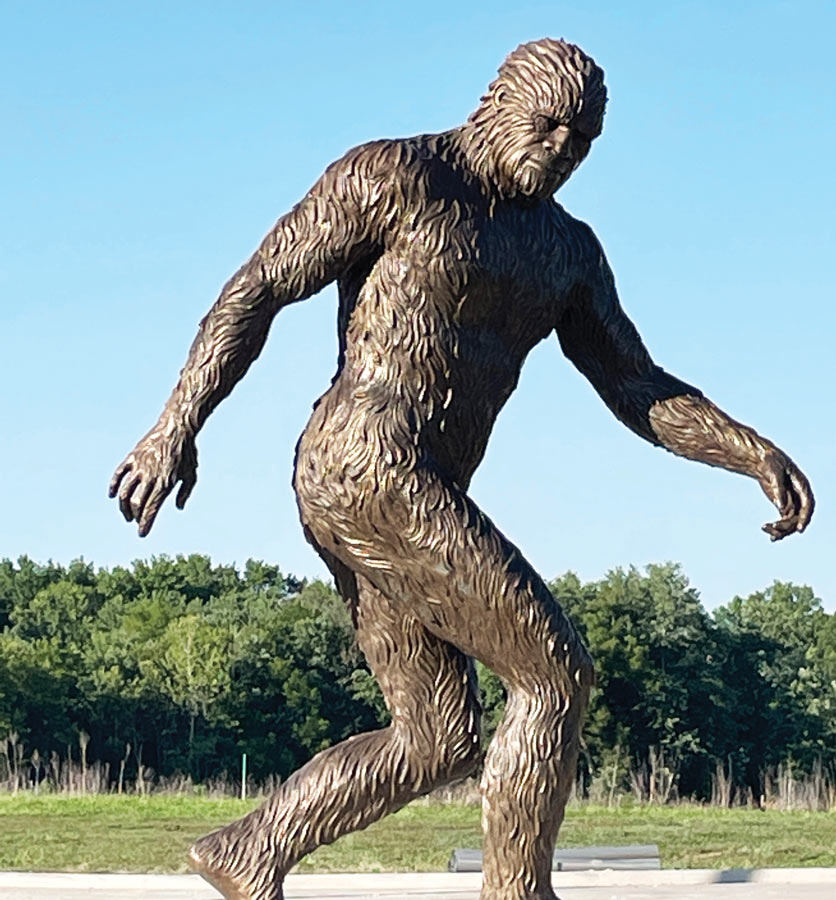 Harold Benny will never forget the first time he saw it. He should not have been surprised; after all, he was looking for it. Still, the image is etched in his memory. The Hillsboro resident was walking one night down a dark Oklahoma mountain road years ago when he saw something move in the woods.
Harold Benny will never forget the first time he saw it. He should not have been surprised; after all, he was looking for it. Still, the image is etched in his memory. The Hillsboro resident was walking one night down a dark Oklahoma mountain road years ago when he saw something move in the woods.
“I started watching, and this great big animal was peeking over a bush, looking at me,” Benny, who describes himself as a naturally curious person, recalls. “It was no more than 40 feet away, and I watched it for at least 40 seconds.”
A companion saw it, too, leaning against a tree in a different spot. The pair were convinced they encountered an elusive creature. Call it Bigfoot, Sasquatch, Yeti or any of the names given to ape-like creatures that have become the subjects of legends, lore and tales for generations.
“Once you see one, you tend to believe that they are really there,” Benny adds. “I mean, he was no more than 40 feet away from me and, yeah, I didn’t get a real precise look at everything, [but] I know that there was a great big animal — 7 feet tall or more — just feet from me.”
Before dismissing Benny and his Bigfoot sightings (he also saw another creature a few years later in Arkansas), know this: Benny is a scientist — a graduate of Eastern Illinois University with two degrees in zoology; a former educator who taught biology and anatomy for years; and later the chief analytical chemist for a major chemical plant.
Although his “encounters” were in different states, Benny has searched throughout Illinois for Bigfoot, researched the creature and talked with dozens of residents of the Prairie State who have their own stories.
Across Illinois, stories of encounters are numerous. In fact, the Bigfoot Field Research Organization (BFRO), an international group that investigates possible Sasquatch sightings, has a long list of Illinois experiences. The state ranks fifth in the nation for what the BFRO calls “credible” reports over the last 30 years, but what exactly are people seeing?
What is Bigfoot?
First, it is important to note that most of the scientific community considers the evidence proving the existence of Bigfoot to be unsubstantiated. However, enthusiasts and cryptozoologists — scientists like Benny who research and study reports of Sasquatch encounters — continue to gather potential evidence, document sightings and look for the creature.
Sighting reports in Illinois usually come from rural areas, forests and remote regions and often include catching a glimpse of a large, ape-like creature standing as tall as 9 feet with a strong, muscular build and covered in hair.
The BFRO reports that people have reported seeing similar beings for hundreds of years. Paul Garber, a retired anthropologist from the University of Illinois, has studied non-human primates for more than four decades. He says many believe that if Bigfoot does exist, it is a primate that has evolved over decades in North America, but he has doubts.
“I would say none of the evidence I am aware of would make it likely that Bigfoot is a primate,” he explains, going into depth about how primates — apes, chimps, gorillas, orangutans and even humans — build nests. “Yet no one, to my knowledge, has found a Bigfoot nest, which would be pretty big and conspicuous.”
He adds that other factors also make him doubt the validity of Bigfoot sightings. “We should be able to find fecal or skeletal remains,” he continues. “We don’t have evidence of caches of food or where they have been eating.”
He also says primates are social and would have “family groups” but knows of no reports of smaller creatures. Yet, he does not completely discount eyewitness accounts; he likens them to sightings of unidentified flying objects. “I believe people are seeing something, but what they see, I don’t know. To me, a much more likely explanation is a bear,” he says.
Even academics are trying to make sense of the chaos. Western Illinois University offers a course that dives into the history of Sasquatch and other unconfirmed creatures, such as the Loch Ness Monster. The course, “Fantastic Archaeology: Ancient Astronauts, Shape Shifters and Bigfoot,” is taught by Michael Lorenzen, who has gathered Bigfoot stories and evidence for years. “I’m skeptical on this issue, but I listen to people and have lots of stories that I’ve collected,” Lorenzen says. “I’ve got an open perspective on it.”
Lorenzen says he first became interested in Bigfoot by watching television shows on the creature when he was a child. In addition to the anthropology course, he also teaches a non-credit class on Bigfoot in Illinois. “People often come and tell me their stories. Sometimes, I’ve gone to their homes and taken reports.”
He says his goal is not necessarily to prove the existence of the creatures but to capture the tales. “Whether or not Bigfoot is real is important, but it’s not as important to me as getting the stories. We’re getting good folklore here. It’s important to get these accounts,” he says.
However, he says people are often reluctant to share what they have seen for fear of ridicule. Noted Bigfoot researcher and author Chad Lewis agrees. “The vast majority of people who see something they would call Bigfoot or Sasquatch don’t report it,” he says. “They don’t know who to report it to or they may simply try to rationalize it away.”
Lorenzen says he doesn’t necessarily believe all the stories, but he doesn’t necessarily not believe them, either. Regardless, he would like to see more evidence.
“I think it is unlikely they’re out there,” he states. “Such a large mammal would have to have a sizeable breeding population, large geographic areas to maintain a viable genetic pool, and they’d have to be constantly moving, so at some point, someone would see them. It’s unbelievable that one never gets hit by a car or there never is indisputable video evidence. It’s not like people aren’t looking for them, we’re just not finding them.”
Lorenzen continues, “Does that mean they don’t exist? No. Maybe they’re really that good at hiding. It’s just difficult for me to think they’re there, but I would love to be wrong. I’m cautious and skeptical, but I’m still optimistic there’s something out there.”
Making their home in Illinois

Illinois seems to be a hotbed for sightings. The BFRO lists more than 300 “credible” sightings in the state since the organization was founded in the 1990s and investigates the sightings using a network of field researchers. Benny used to be one. BFRO’s founder, Matt Moneymaker, says the organization has at least a dozen investigators in Illinois. He is convinced that Bigfoot is real.
“You could have all the evidence presented in front of you … and it will all make sense intellectually, but something’s going to hold you back from totally believing that they’re real until you see one yourself,” he says.
Lorenzen says if these creatures are real, Illinois is the perfect place for them. “We have a lot of wilderness here, and most of the state does not have a heavy population. There are lots of places for a large animal like Bigfoot to hide,” he says.
“In Illinois, there is a variety of terrain. You have prairie areas, you have farmland, plenty of agriculture and plenty of water. In the Shawnee National Forest, you have heavily forested areas — these all provide habitat, food and water,” Lewis outlines.
Moneymaker says the environments that are beneficial to wildlife also might be perfect for Bigfoot and related creatures, adding that deer may also attract them.
“Illinois has agriculture with corn, soybeans and other crops,” he explains. “There is a mixture of agriculture and forest, and that tends to make deer populations boom. Bigfoot fits in the ecosystem as omnivorous, and they eat all sorts of things, but one of their main staples is deer, and there are a lot of deer in Illinois.”
Some areas have more Bigfoot sightings than others. The area around Argyle Lake has had several, as has the rural areas west of Springfield toward the Mississippi River, and the Shawnee National Forest in deep southern Illinois.
The fascination
Drive anywhere in Illinois, and you may see bumper stickers (“I Brake for Bigfoot!”), monuments (Herod and Harrisburg — both near the Shawnee National Forest — are two communities with Bigfoot statues) and yard ornaments. What’s with the Sasquatch obsession?
“It is two-part,” Lewis explains. “I think it’s not knowing whether or not we’ve discovered every species on the planet and maybe there’s something else out there. I also think people love stories of monsters because they are something different. These legends make places unique. Many people in these towns may not necessarily believe the stories, but they love the legends and the folklore. More and more communities are promoting their history, even if it is bizarre.”
If any Illinois community has embraced a Bigfoot-like creature, it is the Jackson County seat of Murphysboro, where there have been numerous reports of a tall, furry, white-colored creature along the banks of the Big Muddy River. Alleged encounters date back 50 years ago when what is now known as the Big Muddy Monster was seen by a couple parked one night at a public park along the river.
The sighting is deemed credible for a variety of reasons, including the fact that the witnesses — who were married, but not to each other — were willing to come forward with their tale. Police files about the incident remain available on the city’s website. Numerous sightings have been recorded since.
In recent years, area residents have begun celebrating the creature with everything from a festival in its honor to murals and a 9-foot bronze statue not far from the Big Muddy River.
“The Big Muddy Monster is huge for the community,” explains Murphysboro Mayor Will Stephens. “It’s imbued into Murphysboro in a lot of ways. We’re proud of it, and it’s just another thing that makes Murphysboro unique.”
Stephens says he personally has never encountered the creature, but he tries to keep an open mind. “I think the people who have reported things are sincere, and whether the Big Muddy Monster is ultimately a grizzly bear or something else, we’ll never know. But some things that are noted cannot be just strictly the figments of people’s imaginations.”
Real or imagined, Bigfoot has captured people’s attention. Some believe, some don’t, and others are unsure. Take Benny for example: “There’s just a lot of things that, being a zoologist, don’t make sense to me. But I saw it.”










